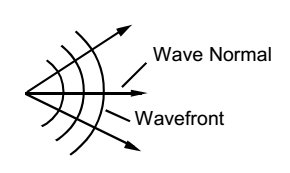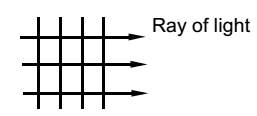Science > Physics > Wave Theory of Light > Introduction to Wave Theory of Light
In this article, we shall study various theories proposed to explain the nature of light. The main focus of the article will be on Huygens’s wave theory of light
Newton’s Corpuscular Theory of Light
Assumptions of Newton’s Corpuscular Theory of Light:
- The proposition of Existence of Corpuscles: According to corpuscular theory, every source of light emits minute, perfectly elastic particles of negligible mass known as ‘Corpuscles’. That is light energy emitted by any source consists of a tiny stream of particle.
- Explanation of Rectilinear Propagation of Light: According to Newton, Corpuscles are unaffected by the force of gravity and they travel in a straight line away from its source at very high speed. This explains the rectilinear propagation of light.
- Explanation of Sensation of Vision: When corpuscles fall on the eye, they produce a sensation of vision.
- Explanation of Different Colours: The various colours of light are due to different sizes and masses of the Corpuscles. The brightness of a surface depends on the number of Corpuscles incident on it.
- Explanation of Opacity: The ‘Corpuscles are so small that they can pass through the intermolecular space of transparent substances. However, the size of Corpuscles is larger than intermolecular space of opaque substances, so that they are stopped by them.
- Explanation of Reflection and Refraction: To explain reflection and refraction of light, Newton proposed that Corpuscles are repelled by a reflecting surface whereas they are attracted by a refracting surface.
- Explanation of Partial Reflection and Partial Transmission: Partial reflection and partial transmission of light from a substance like the glass were explained by using a ‘theory of fits’. According to this, theory, the Corpuscles are alternately attracted and repelled from such a surface.8. On the basis of Corpuscular theory, Newton was able to explain the phenomenon of rectilinear propagation, reflection and refraction of light.
Drawbacks of Newton’s Corpuscular Theory of Light:
- Newton’s Corpuscular theory predicted that the velocity of light is more in an optically denser medium than that in the rarer medium. Foucault’s experimental observation disproved it.
- On the basis of Corpuscular theory, Newton’s explanations for partial reflection and refraction was unsatisfactory.
- The phenomenon of reflection and refraction was not explained satisfactorily.
- The corpuscular theory fails to account for interference, polarization and diffraction of light.
- As Corpuscles were assumed as particles, there should be a small decrease in mass of a source which emits light continuously for a long time. There was no experimental evidence for it.
Maxwell’s Electromagnetic Theory:
Maxwell proposed the existence of electromagnetic waves. He obtained the relation between magnetism and electricity. He assumed light to be in the form of electromagnetic waves due to the fact that the velocity of electromagnetic waves is equal to that of light.
He observed that the electromagnetic waves do not require any medium for their propagation hence they can travel through a vacuum. Thus the propagation of light in vacuum can be explained by assuming them to be electromagnetic waves.
Max Planck’s Quantum Theory:
To explain black body radiations Max Planck proposed this theory. He proposed that the light is propagated in the form of light energy called quanta or photon. Each photon or quanta has energy given by E = h υ. Where ‘h’ is Planck’s constant and ‘υ’ is the frequency of the photon.
Huygens’s Wave Theory of Light:
- According to wave theory, light from a source is propagated in the form of longitudinal waves with uniform velocity in a homogeneous medium. (Later it was proved that the light waves are transverse waves).
- These waves emitted by the source move in a straight in a homogeneous medium.
- To explain the propagation of light through a vacuum, Huygens assumed the existence of a hypothetical (imaginary) elastic medium called luminiferous ether. According to Huygens, ether particles are all-pervading (present everywhere) and possess properties such as inertia, zero density and perfect transparency.
- On the basis of Huygens wave theory, various colours of light are due to different wavelengths of the light waves.
- When light enters our eyes we get the sensation of light.
Merits of Huygene’s Wave Theory of Light:
- On the basis of the wave theory, the phenomenon of reflection, refraction, diffraction, interference, polarization and total internal reflection of light could be explained.
- Wave theory correctly predicted that velocity of light in an optically denser medium is less than that in a rarer medium which is in agreement with experimental results.
- On the basis of the wave theory, partial reflection and refraction of light could be explained without making contradictory hypotheses.
Demerits of Huygene’s Wave Theory of Light:
- Wave theory assumes the existence of luminiferous ether. However, experimental attempts to detect the presence of ether particle were unsuccessful.
- Huygen’s theory could not explain the rectilinear propagation of light.
- The phenomena of the photoelectric effect, Crompton effect in Modern Physics cannot be explained using wave theory.
Important Concepts in Wave Theory of Light:
Wavefront:
A wavefront is defined as the locus of all the points of a medium, which receives light wave disturbance simultaneously so that all these points are, in the same phase.
Wave Normal:

A perpendicular drawn to the surface of a wavefront at any point in the direction of propagation of light is called Wave Normal.
Ray of Light:

The direction in which light is propagated is called the ray of light. Thus ray of light is always perpendicular to the wavefront.
From Huygens’ concept of the wavefront, it is clear that a wavefront always moves parallel to itself in a homogeneous medium. This means that the wavefront always carries light energy in a direction perpendicular to its surface.
This can be represented by drawing a normal at any point in that direction. The direction of propagation of a wavefront is given by a ray of light. Therefore, a wave normal represents a ray of light.
Types of Wave Fronts:
Spherical Wavefront:

Consider a point source of light S placed in air. The source will emit waves of light in all possible directions. If the velocity of light in air is c, then in time ‘t’, each wave will cover a distance ct. Therefore, at the end of time interval ‘t’ the light emitted, by, the source will reach at all points like a sphere with centre S and radius equal to ct. All the points on the surface of this sphere are in the same phase. Such a spherical surface is called spherical. wavefront. Thus spherical wavefront is given by a point source.
Plane Wavefront:

Consider a spherical wavefront of very large radius. At a very large distance from a point source of light, the spherical wavefront is so large that a small part of its surface can be considered as a plane surface i.e. a plane wavefront. Light from the sun reaches the surface of the earth in the form of plane wavefronts. Theoretically, the plane wavefront is obtained only at infinite distance from a point source.
Cylindrical Wavefront:

If a source of light is linear i.e. in the form of slits the wavefront originating from it has the shape of a cylinder. Such a wavefront is called a cylindrical wavefront.
Characteristics of Wavefront:
- A locus of all the points of a medium, to which light waves reach simultaneously so that all these points are in the same phase is called a wavefront.
- Wavefront travels with the speed of light in all directions in an isotropic medium.
- They always travel in the forward direction.
- The perpendicular line drawn at any point on the wavefront represents the direction of propagation of the wave at that point and is called the wave normal or ray of light.
Characteristics of Primary Source of Light:
- It is a real source of light.
- It generates life itself.
- It sends primary waves in all the direction.
- Generally, the primary source of light is in the air.
Characteristics of Secondary Source of Light:
- It is a fictitious source of light
- A secondary source of light is one that accepts incoming light and transforms it in some way, via reflection, refraction, diffusion, etc.
- It sends out secondary waves only in the forward direction.
- The secondary source is situated on the wavefront.
Next Topic: Applications of wave Theory of Light